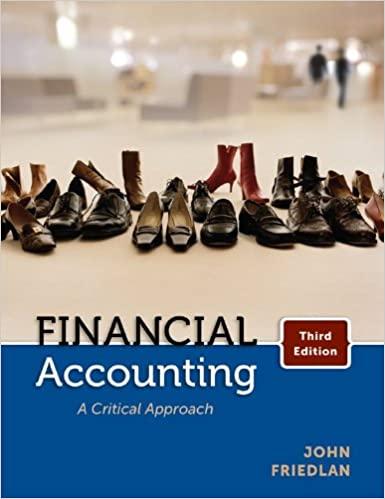Weve Got Wheels, Inc. (Wheels) was formed on May 1, 2014 by two university friends who thought
Question:
We’ve Got Wheels, Inc. (Wheels) was formed on May 1, 2014 by two university friends who thought they could make money renting bikes and inline skates to visitors at a busy lake-front area near their homes. The friends thought the business would be a good way to spend their summer near the beach while making enough money to finance next year’s university costs. If the business is successful the friends hope to operate it for as long as they attend university.
The two owners closed down Wheels for the year after the Labour Day weekend.
It was a very hectic summer and they didn’t have nearly as much time to have fun as they thought they would. They were also so busy that they didn’t pay much attention to keeping any accounting records. They did, however, keep all the receipts, invoices, and deposit slips that accumulated over the summer.
It’s now September 10. The owners have asked you to compile useful information about Wheels for them. After summarizing the data they provided, you have the following information for the summer of 2014:
i. May 1: Each friend contributed $9,000 in cash to Wheels in exchange for stock in the company.
il. May 5: Purchased 30 new and used bicycles for a total of $10,500. Wheels agreed to pay $6,000 immediately and the remainder on September 30, 2014. The owners think the bikes will last for at least three summers, after which time they will no longer be useful for the business.
ii. May 9: Obtained a permit to operate a business at the lake. The cost of the permit was $150 for the summer.
iv. May 10: Purchased 50 sets of inline skates and 50 sets of protective equipment for $6,750 in cash. The owners think that the most they will get out of this equipment is about two summers of use.
v. During the summer: Wheels rented bicycles and skates to customers for $41,625 cash.
vi. During the summer: Purchased packaged snacks for $2,200 cash. At the end of the summer there was $450 of snacks left over. The snacks were sold to customers through the summer for $3,575 cash.
vii. During the summer: Purchased advertising on a local radio station. Advertising was paid for by cheque once an ad was played. Total amount spent during the summer was $1,500. Nothing was owing at the end of the Labour Day weekend.
viii. During the summer: Wheels provided inline skating lessons to children on behalf of the local Parks and Recreation Department. Wheels billed the department $3,500 for the lessons. As of September 10, $2,250 was still owed to Wheels. The amount owed is due on October 15.
ix. During the summer: Wheels incurred other expenses amounting to $12,500. All were paid in cash.
x. During the summer: The owners took $7,500 each to meet their personal needs.
Required:
a. Enter each of the transactions onto an accounting equation spreadsheet. You can use a computer spreadsheet program or create a spreadsheet manually. Create a separate column on the spreadsheet for each account.
b. Provide explanations for each of your entries. You should explain why you have treated the economic events as you have (that is, why you have recorded an asset, liability, etc.).
c. Prepare a balance sheet as of September 10, 2014 and an income statement for the period ended September 10, 2014 from your spreadsheet. Make sure to make the closing entry.
d. Explain why the financial statements you have prepared would be useful to the owners of Wheels.
e. Compare Wheels’ net income with the amount of cash that was generated by the business. Which is a better indicator of how Wheels did? Why are they different?
(When looking at the cash flow consider the cash flows after the owners made their initial $18,000 investment.)
f. If Wheels’ owners asked you to evaluate the financial statements for them, what would you be able to tell them?
Step by Step Answer:






